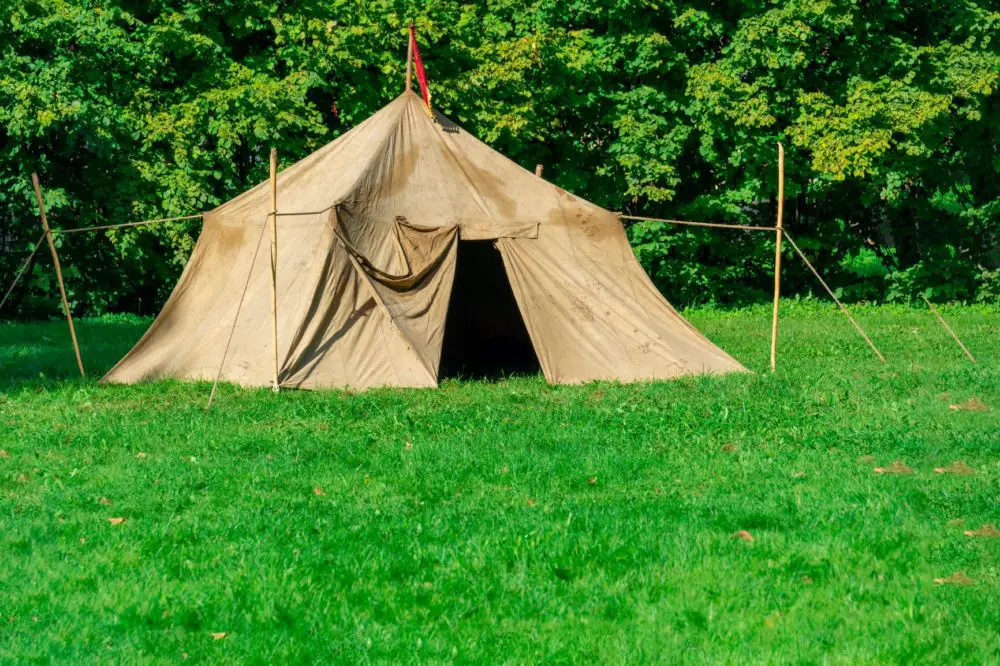I’d rather be in a tent than a house - Mary Leakey
While it’s rare that you’ll be caught without a tent when you set off to go camping, it can and does happen.
Whether the weather turned against you and huffed and puffed, and blew your tent down or damaged it, or for a whole multitude of different reasons you’ve either left home without your tent, were separated from it at a previous campsite or it ended up getting lost somewhere along the trail, you can easily find yourself in the middle of nowhere, in need of shelter and with only the most basic of camping equipment in your backpack to make it from.

Even though it might seem like that’s the ideal moment to begin to panic, it really isn’t and there’s absolutely no need to give in to fear.
We’ve all been there and we’ve all found ourselves in a similar situation. And that’s why we’re going to guide you through the simple steps that you’ll need to follow in order to build yourself a camping tent from scratch.
Table of Contents
Prepping Your Tarpaulin
When you’re hiking or camping, you’ll almost certainly have a tarpaulin or some sort of plastic groundsheet folded up in your rucksack.
We all know how handy and useful they can be when you’re setting up camp and need somewhere to sit while cooking that isn’t soaking wet.
But the real reason, and the one that a lot of experienced hikers and campers won’t tell you about because they’re too embarrassed to share their own tales of woe and misfortune with you, that you should always have one folded and ready to go, is for those moments when calamity and misfortune strike and you find yourself without a tent, far from home.
The first thing you need to do to your tarp or groundsheet is make a small hole in each of the four corners and one on the edge of the sheet in between each corner.
That makes a total of eight holes - some campers will tell you that you only actually need to make four holes (one in each corner), but we’ve always believed that it’s better to be safe than sorry, so we’ve always made an extra set, just to be that little bit more cautious.
And the reason that you’re also told to carry rope? This is it. Take the rope out of your backpack, cut it into eight equal lengths, and thread one of the lengths through each of the holes that you’ve just made.
Location, Location, Location
Location is everything. You’ll need to find a patch of level ground that’s soft enough for you to drive the posts (more of which in a minute) of your improvised tent into.
Once you’ve found your ideal patch of ground, lay your tarp/groundsheet on it and stretch it as far as you can in order to make sure that you have enough room to set your tent up and make camp.
As soon as you’re sure that you do have enough room, you’ll need to locate the posts, or pegs that you’re going to use in order to create your tent.
Finding The Posts / Tent Pegs
If you don’t have your tent with you, the chances are that you’re not going to have any of the poles, or the stakes and pegs that are and parcel of it with you either.
So you’re going to need to adapt to the circumstances you’ve found yourself in and turn to nature for a helping hand.
What makes ideal posts and tent pegs or stakes? Sticks and branches do. Scout around for a bit and try to find a thick, two or three-foot-long branch that’s quite sturdy (this is going to be the central pole of your tent) and some smaller sticks, you’re going to need seven of them, that are going to become the stakes or pegs of your tent.
Setting Up Your Tent
When you’ve found the branch and the sticks, make your way back to the patch of ground that you laid your tarp out on. Find the middle of the tarp, and carefully fold the sheet back on itself, remembering where the middle was.
Push the sturdy branch into the ground where the middle of your tarp was - you might (and by might, we mean will) want to hammer it into place with a rock to make sure that it’s secure, so be prepared for a little physical exertion.
Once the branch or the middle pole of your tent is firmly embedded in the ground, place the middle of the tarp over it and gently stretch its edges out as far as they will go. In order to do this, you’ll either need a friend to give you a little help, or you’ll need to weigh each corner down with a stone.
Ideally, your tarp should look a little like a pyramid at this point, and when it does, hammer one of the sticks you also collected through each of the holes that you made in the tarp earlier.
While you’re doing this, remember to leave one corner and one of the middle holes free - you need to get into your tent before you seal it for the night, and the corner will provide the entrance that you’ll need.
Make sure that all of the other six pegs/stakes are firmly secured into the ground (it won’t hurt to also hammer them into the ground with the same rock that you used to hammer the central pole/branch into place) and once you’re satisfied that they are secure, tie the rope that you earlier threaded through each of the holes to the stake or peg sharing its hole.
Tying the tarp to the improvised stakes helps to secure your tarp, and thus your makeshift tent, in place.
Taking Shelter
The corner that we told you to leave free? That’s where you’re going to enter your tent, and once you’re inside, you’re going to need to hammer a stake through it to secure it, before tying that corner off with the length of rope that’s already been threaded through the hole in the same way that you did with the other stakes/sticks outside of your improvised tent.
Right now, you’re probably thinking about the eighth hole with the length of rope threaded through it and wondering why we haven’t told you to hammer a stick through that hole to secure it in place. We haven’t told you to do it, because you don’t need to do it.
Loosely tie the length of rope that you threaded through the unsecured eighth hole to one of the other stakes - it doesn’t need to be tied as tightly as the other lengths of rope were, because this is going to be your emergency exit if you need to get out of your tent in a hurry in the middle of the night.
If it’s loosely tied, you’ll be able to undo it quickly and wiggle out under the tarp if you need to. Once you’ve finished, you’ll be safe from the elements in your makeshift tent.
When you need to leave in the morning, just use your ad-hoc hammer (or rock as it’s more commonly known) to loosen one of the corner stakes (or sticks) then take it out, and you’ll be free to leave your shelter. It might not be the best-looking tent that you’ll ever sleep in, but at least it’ll keep you warm and dry.
- Are Merrell Shoes Good? – An Unbiased Review of Merrell Footwear - December 9, 2023
- Where Are Merrell Shoes Made? - December 9, 2023
- Camping in 40-degree Weather: Tips and Tricks - September 25, 2023

![How to Make a Tent Warmer? [Easy & Simple Steps] How to Make a Tent Warmer? [Easy & Simple Steps]](https://grandcircletrails.com/wp-content/uploads/2022/10/How-to-Make-a-Tent-Warmer-1-150x150.jpg)

![How to Make Toast While Camping? [Methods You Need To Try] How to Make Toast While Camping? [Methods You Need To Try]](https://grandcircletrails.com/wp-content/uploads/2022/07/How-to-Make-Toast-While-Camping-150x150.jpg)

![Can You Bring Trekking Pole on Plane? [Make Sure To Read On] Can You Bring Trekking Pole on Plane? [Make Sure To Read On]](https://grandcircletrails.com/wp-content/uploads/2022/12/Can-You-Bring-Trekking-Pole-on-Plane-150x150.jpg)
![How to Make a Folding Chair More Comfortable? [7 Tips] How to Make a Folding Chair More Comfortable? [7 Tips]](https://grandcircletrails.com/wp-content/uploads/2022/05/How-to-Make-a-Folding-Chair-More-Comfortable-150x150.jpg)